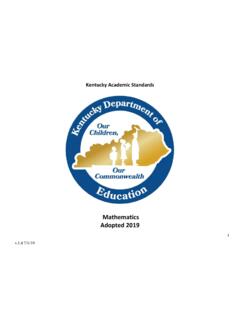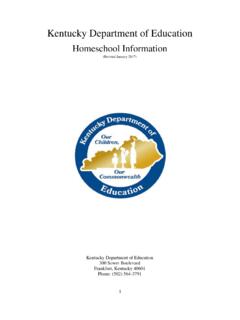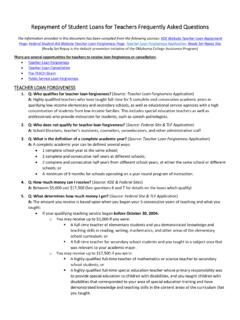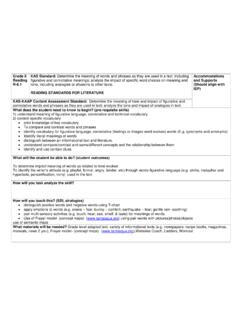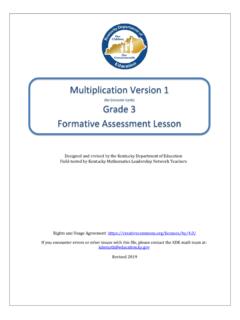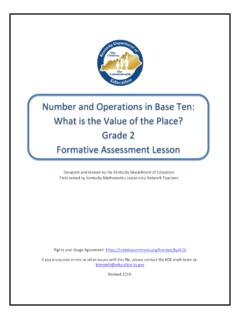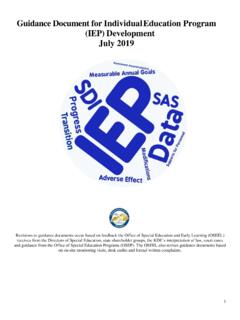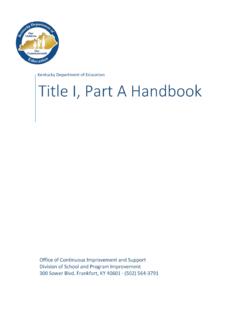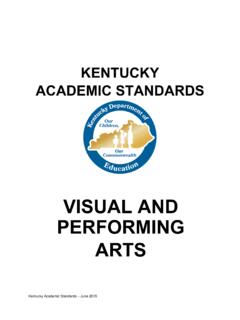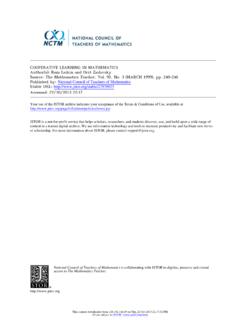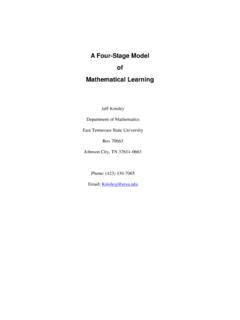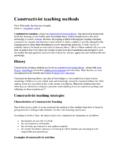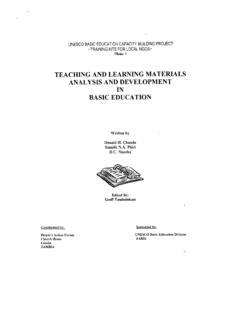Transcription of Characteristics of High Quality Mathematics …
1 Characteristics of high Quality Mathematics teaching and learning in Kentucky Schools Introduction This document is an effort to describe the roles of the teacher and student in an exemplary Mathematics instructional environment. The focus of the document is on the instructional core at the center of the educational process as described in detail in the Public Education Leadership Program (PELP). Future documents will address the outer ring factors that are present in Mathematics classrooms in high achieving schools and districts essential resources for Mathematics programs, stakeholder involvement, the learning culture, structures and system components, including sustained high Quality professional learning opportunities for teachers who are at the core of the instructional process.
2 Kentucky Department of Education September 2007 1 Characteristics of high Quality Mathematics teaching and learning in Kentucky Schools Note: The following documents are not cited in the table below as they are the original sources and embody the vision for the Characteristics , the overviews of all Mathematics standards-based content, instruction, and assessment, and the frameworks that initiated the ideas about which the research was conducted: National Council of Teachers of Mathematics (NCTM).
3 (2000). Principles and Standards for School Mathematics . Reston, VA: NCTM. National Council of Teachers of Mathematics (NCTM). (1995). Assessment Standards for School Mathematics . Reston, VA: NCTM. National Council of Teachers of Mathematics (NCTM). (1991). Professional Standards for teaching Mathematics . Reston, VA: NCTM. National Council of Teachers of Mathematics (NCTM). (1989). Curriculum and Evaluation Standards for School Mathematics . Reston, VA: NCTM. In addition, the following document was developed to serve as a companion to the Principles and Standards for School Mathematics (2000). It synthesizes a sizable portion of the literature that provides the foundation for the Standards.
4 National Council of Teachers of Mathematics (NCTM). (2003). A Research Companion to Principles and Standards for School Mathematics , J. Kilpatrick, G. Martin, and D. Schifter (Eds.). Reston, VA: NCTM. 1. Knowledge of Content Research Connections The teacher: A. Demonstrates an understanding of all pedagogical Mathematics content and an ability to convey this content to students B. Keeps abreast of current developments in Mathematics 1A, 1B, 1C, 1D, 1E. National Research Council. (2001). Adding it up: Helping children learn Mathematics . J. Kilpatrick, J. Swafford, and B. Findell (Eds.). Mathematics learning Study Committee, Center for Education, Division of Behavioral and Social Sciences and Education.
5 Washington, DC: National Academy Press. * Chapter 2, The State of School Mathematics in the United States, pp 31-36: Since the establishment of the NCTM Curriculum and Evaluation Standards for School Mathematics in have developed content standards or curriculum frameworks describing what students should know and be able to do in Mathematics . *Chapter 7, Developing Proficiency with Other Numbers, pp 231-254: Many students acquire useful informal knowledge of fractions, decimals, ratios, percents, and that knowledge needs to be made more explicit and extended through carefully designed disconnections that many students exhibit among their conceptual understanding, procedural fluency, strategic competence, and adaptive reasoning pose serious barriers to their progress in learning and using Mathematics .
6 Kentucky Department of Education September 2007 2 Characteristics of high Quality Mathematics teaching and learning in Kentucky Schools C. Designs standards-based courses/lessons/units using Kentucky s Program of Studies Revised 2006, Academic Expectations, and Core Content for Assessment Version D.
7 Demonstrates that mathematical understandings are outcomes of solving meaningful problems rather than merely of procedural instruction E. Encourages students to analyze Mathematics by identifying the underlying procedures, applying mathematical knowledge, and making generalizations F. Uses and promotes the understanding of appropriate Mathematics vocabulary G. Provides essential supports for students in Mathematics who are learning English or have limited English proficiency The students: H. Use and seek to understand appropriate Mathematics vocabulary *Chapter 8, Developing Mathematical Proficiency Beyond Number, pp 255-280: Students can learn to express the laws (of arithmetic) algebraically and can use them to support their reasoning and to justify their claims about become aware of the role played by general statements expressed in algebraic symbols when justifying numerical arguments or discussing classes of situations.
8 * Chapter 10, Developing Proficiency in teaching Mathematics , pp 369-405: Teachers knowledge is of value only if they can apply it to their programs of teacher preparation and professional development cannot stop at simply engaging teachers in acquiring knowledge; they must challenge teachers to develop, apply, and analyze that knowledge in the context of their own classrooms so that knowledge and practice are integrated. *Chapter 11, Conclusions and Recommendations, pp 420-421: Problem solving should be the site in which all of the strands of Mathematics proficiency converge; and pp 428-431: Very few (K-8) teachers currently have the specialized knowledge needed to teach Mathematics in the way envisioned in this development in Mathematics needs to be sustained over time that is measured in years, not weeks or months.
9 1D, 1E, 1I, 1J. National Research Council. (2005). How Students Learn: Mathematics in the Classroom. Committee on How Students Learn, A Targeted Report for Teachers, Donovan and J. D. Bransford, (Eds.). Division of Behavioral and Social Sciences and Education. Washington, DC: The National Academies Press. *Chapter 5, Mathematical Understanding: An Introduction, pp 217-236:..teach Mathematics so students come to appreciate that about solving important and relevant quantitative that the rules for computation and solution are a set of clever human inventions that allow us to solve complex problems more easily, and to communicate about those problems with each other effectively and can we link formal Mathematics training with students informal knowledge and problem-solving capacities?
10 *Chapter 7, Pipes, Tubes, and Beakers: New Approaches to teaching the Rational-Number System, pp 309-349: Rational number concepts underpin many topics in advanced Mathematics and carry significant academic consequences. Students cannot succeed in algebra if they do not understand rational numbers. But rational numbers also pervade our daily *Chapter 8, teaching and learning Functions, pp 351-393: ..importance of building new knowledge on the foundation of students existing knowledge and should help students develop a conceptual understanding of function, the ability to represent a function in a variety of ways, and fluency in moving among multiple representations of Functions are all around us, though students do not always realize tools allow us to express these functional relationships very to solve highly complex problems and display in a way that provides a powerful image of change over time.
